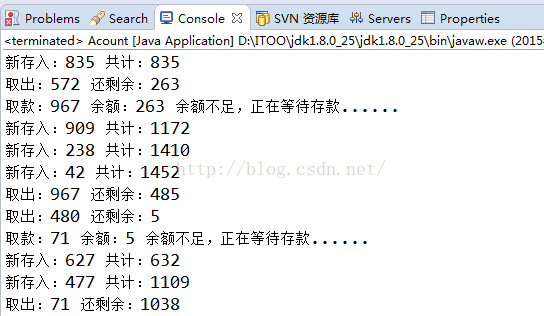原文地址:http://blog.csdn.net/hejingyuan6/article/details/47053409#
多线程共享数据的方式:
1,如果每个线程执行的代码相同,可以使用同一个Runnable对象,这个Runnable对象中有那个共享数据,例如,卖票系统就可以这么做。
2,如果每个线程执行的代码不同,这时候需要用不同的Runnable对象,例如,设计4个线程。其中两个线程每次对j增加1,另外两个线程对j每次减1,银行存取款
有两种方法来解决此类问题:
将共享数据封装成另外一个对象,然后将这个对象逐一传递给各个Runnable对象,每个线程对共享数据的操作方法也分配到那个对象身上完成,这样容易实现针对数据进行各个操作的互斥和通信
将Runnable对象作为一个类的内部类,共享数据作为这个类的成员变量,每个线程对共享数据的操作方法也封装在外部类,以便实现对数据的各个操作的同步和互斥,作为内部类的各个Runnable对象调用外部类的这些方法。
每个线程执行的代码相同,可以使用同一个Runnable对象
卖票系统demo:
package com.xujishou; public class SellTicket { /** * @param args */ public static void main(String[] args) { Ticket t = new Ticket(); new Thread(t).start(); new Thread(t).start(); } } class Ticket implements Runnable { private int ticket = 10; public void run() { while (ticket > 0) { ticket--; System.out.println("当前票数为:" + ticket); } } }
执行

简单的多线程间数据共享,每个线程执行的代码不同,用不同的Runnable对象
设计4个线程。
其中两个线程每次对j增加1,另外两个线程对j每次减1
package com.xujishou; public class TestThread { /** * @param args */ public static void main(String[] args) { final MyData data = new MyData(); for (int i = 0; i < 10; i++) { new Thread(new Runnable() { public void run() { data.add(); } }).start(); new Thread(new Runnable() { public void run() { data.dec(); } }).start(); } } } class MyData { private int j = 0; public synchronized void add() { j++; System.out.println("线程" + Thread.currentThread().getName() + "j为:" + j); } public synchronized void dec() { j--; System.out.println("线程" + Thread.currentThread().getName() + "j为:" + j); } }

银行存取款实例:
package com.xujishou; public class Acount { private int money; public Acount(int money) { this.money = money; } public synchronized void getMoney(int money) { // 注意这个地方必须用while循环,因为即便再存入钱也有可能比取的要少 while (this.money < money) { System.out.println("取款:" + money + " 余额:" + this.money + " 余额不足,正在等待存款......"); try { wait(); } catch (Exception e) { } } this.money = this.money - money; System.out.println("取出:" + money + " 还剩余:" + this.money); } public synchronized void setMoney(int money) { try { Thread.sleep(10); } catch (Exception e) { } this.money = this.money + money; System.out.println("新存入:" + money + " 共计:" + this.money); notify(); } public static void main(String args[]) { Acount Acount = new Acount(0); Bank b = new Bank(Acount); Consumer c = new Consumer(Acount); new Thread(b).start(); new Thread(c).start(); } } // 存款类 class Bank implements Runnable { Acount Acount; public Bank(Acount Acount) { this.Acount = Acount; } public void run() { while (true) { int temp = (int) (Math.random() * 1000); Acount.setMoney(temp); } } } // 取款类 class Consumer implements Runnable { Acount Acount; public Consumer(Acount Acount) { this.Acount = Acount; } public void run() { while (true) { int temp = (int) (Math.random() * 1000); Acount.getMoney(temp); } } }

总结:
其实多线程间的共享数据最主要的还是互斥,多个线程共享一个变量,针对变量的操作实现原子性即可。
原文地址:http://blog.csdn.net/hejingyuan6/article/details/47053409#
多线程共享数据的方式:
1,如果每个线程执行的代码相同,可以使用同一个Runnable对象,这个Runnable对象中有那个共享数据,例如,卖票系统就可以这么做。
2,如果每个线程执行的代码不同,这时候需要用不同的Runnable对象,例如,设计4个线程。其中两个线程每次对j增加1,另外两个线程对j每次减1,银行存取款
有两种方法来解决此类问题:
将共享数据封装成另外一个对象,然后将这个对象逐一传递给各个Runnable对象,每个线程对共享数据的操作方法也分配到那个对象身上完成,这样容易实现针对数据进行各个操作的互斥和通信
将Runnable对象作为一个类的内部类,共享数据作为这个类的成员变量,每个线程对共享数据的操作方法也封装在外部类,以便实现对数据的各个操作的同步和互斥,作为内部类的各个Runnable对象调用外部类的这些方法。
下面逐一介绍
每个线程执行的代码相同,可以使用同一个Runnable对象
卖票系统demo:
|
1
2
3
4
5
6
7
8
9
10
11
12
13
14
15
16
17
18
19
20
21
22
23
24
25
|
package
com.xujishou;
public
class
SellTicket {
/**
* @param args
*/
public
static
void main(String[] args) {
Ticket t =
new
Ticket();
new
Thread(t).start();
new
Thread(t).start();
}
}
class
Ticket
implements
Runnable {
private
int ticket = 10;
public void run() {
while
(ticket > 0) {
ticket--;
System.out.println(
"当前票数为:"
+ ticket);
}
}
}
|
执行

简单的多线程间数据共享,每个线程执行的代码不同,用不同的Runnable对象
设计4个线程。
其中两个线程每次对j增加1,另外两个线程对j每次减1
|
1
2
3
4
5
6
7
8
9
10
11
12
13
14
15
16
17
18
19
20
21
22
23
24
25
26
27
28
29
30
31
32
33
34
35
36
37
38
39
40
41
42
43
44
|
package
com.xujishou;
public
class
TestThread {
/**
* @param args
*/
public
static
void main(String[] args) {
final MyData data =
new
MyData();
for
(int i = 0; i < 10; i++) {
new
Thread(
new
Runnable() {
public void run() {
data.add();
}
}).start();
new
Thread(
new
Runnable() {
public void run() {
data.dec();
}
}).start();
}
}
}
class
MyData {
private
int j = 0;
public synchronized void add() {
j++;
System.out.println(
"线程"
+ Thread.currentThread().getName() +
"j为:"
+ j);
}
public synchronized void dec() {
j--;
System.out.println(
"线程"
+ Thread.currentThread().getName() +
"j为:"
+ j);
}
}
|

银行存取款实例:
|
1
2
3
4
5
6
7
8
9
10
11
12
13
14
15
16
17
18
19
20
21
22
23
24
25
26
27
28
29
30
31
32
33
34
35
36
37
38
39
40
41
42
43
44
45
46
47
48
49
50
51
52
53
54
55
56
57
58
59
60
61
62
63
64
65
66
67
68
69
70
71
72
73
74
75
76
77
|
package
com.xujishou;
public
class
Acount {
private
int money;
public Acount(int money) {
this
.money = money;
}
public synchronized void getMoney(int money) {
// 注意这个地方必须用while循环,因为即便再存入钱也有可能比取的要少
while
(
this
.money < money) {
System.out.println(
"取款:"
+ money +
" 余额:"
+
this
.money
+
" 余额不足,正在等待存款......"
);
try
{
wait();
}
catch
(Exception e) {
}
}
this
.money =
this
.money - money;
System.out.println(
"取出:"
+ money +
" 还剩余:"
+
this
.money);
}
public synchronized void setMoney(int money) {
try
{
Thread.sleep(10);
}
catch
(Exception e) {
}
this
.money =
this
.money + money;
System.out.println(
"新存入:"
+ money +
" 共计:"
+
this
.money);
notify();
}
public
static
void main(String args[]) {
Acount Acount =
new
Acount(0);
Bank b =
new
Bank(Acount);
Consumer c =
new
Consumer(Acount);
new
Thread(b).start();
new
Thread(c).start();
}
}
// 存款类
class
Bank
implements
Runnable {
Acount Acount;
public Bank(Acount Acount) {
this
.Acount = Acount;
}
public void run() {
while
(
true
) {
int temp = (int) (Math.random() * 1000);
Acount.setMoney(temp);
}
}
}
// 取款类
class
Consumer
implements
Runnable {
Acount Acount;
public Consumer(Acount Acount) {
this
.Acount = Acount;
}
public void run() {
while
(
true
) {
int temp = (int) (Math.random() * 1000);
Acount.getMoney(temp);
}
}
}
|

总结:
其实多线程间的共享数据最主要的还是互斥,多个线程共享一个变量,针对变量的操作实现原子性即可。